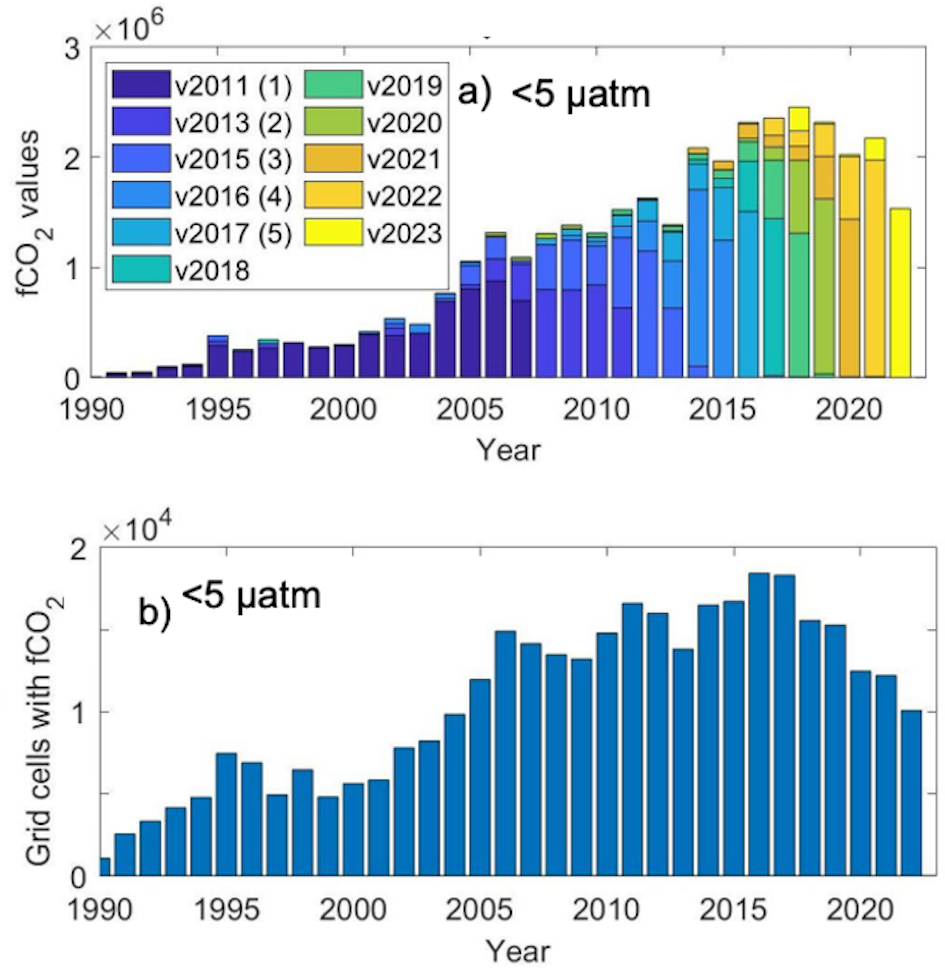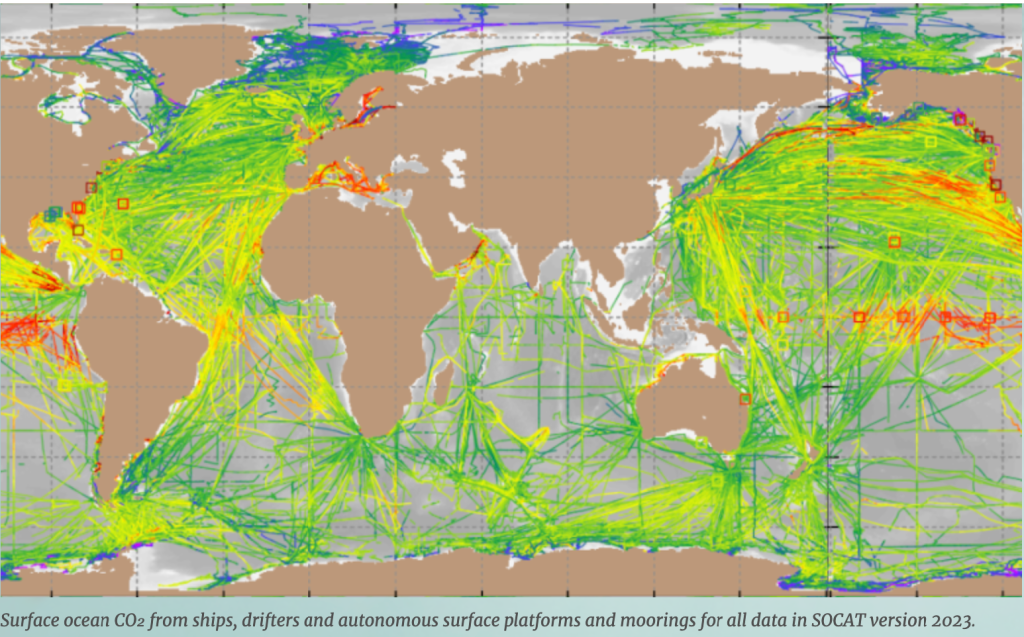Surface Ocean CO2 Atlas (SOCAT) Version 2023 Released
Version 2023 of the Surface Ocean CO2 Atlas (SOCAT), released on June 20, 2023, shows a dramatic decline in carbon dioxide (CO2) observing efforts in the world’s ocean. The number of CO2 measurements provided to SOCAT has decreased by almost half since 2017 due to a slow recovery of ship operations since the COVID-19 pandemic and lack of sustained funding for the international SOCAT project. This lack of data threatens our ability to accurately quantify and assess global ocean CO2 uptake and ocean acidification.
Carbon dioxide is generated by burning fossil fuels for human activities. Like other greenhouse gasses, CO2 traps heat in our atmosphere which leads to warming and amplifies extreme weather like heat waves, droughts, wildfires, precipitation and flooding. The ocean absorbs about 27% of atmospheric CO2 produced by fossil fuel burning every year and stores excess heat, acting as a natural sink to offset the impacts of global climate change caused by greenhouse gasses.
Increasing levels of CO2 and associated warming threaten our world’s ocean, leading to accelerated sea level rise, disruption of marine ecosystems and ocean acidification that endangers marine organisms and ocean health. Our ability to measure the amount of carbon in the ocean is vital for assessing the Earth’s total carbon budget and informing climate policy. Identifying and addressing gaps in the ocean carbon observing system is imperative to be able to understand and respond to the global impacts of climate change.
Rising global CO2 levels threaten the ocean carbon sink
According to the most recent annual Global Carbon Budget, released in November 2022, global CO2 emissions remain at record levels of 40.6 billion tons. NOAA’s Annual Greenhouse Gas Index reported that atmospheric CO2 concentrations averaged 417 parts per million (ppm) during 2022, with a peak of 421 ppm in May 2022 measured at NOAA’s Mauna Loa Atmospheric Baseline Observatory in Hawaii. The steady increase in CO2 levels seen over the years has continued into 2023, with measurements at Mauna Loa peaking at 424 ppm in May 2023 – more than 50 percent higher than pre-industrial levels.

Continued increases in global CO2 levels could affect the ocean’s ability to offset climate change impacts. “Looking at the observational data, we have learned that the ocean’s capacity to be a carbon sink is finite,” said Rik Wanninkhof, an ocean carbon cycle expert at NOAA’s Atlantic Oceanographic and Meteorological Laboratory. Although the ocean continues to absorb atmospheric CO2, the rate of ocean CO2 uptake has reduced over the last decade. Some of this reduction is caused directly by climate change, since warmer oceans dissolve less CO2. NOAA reported record-breaking global temperatures in May 2023 and prevalent marine heatwaves. These warming ocean temperatures lead to lower uptake of CO2, weakening the ocean’s ability to counteract the impacts of rising CO2 emissions.
Global capacity for open ocean CO2 observations is declining
Reducing global atmospheric CO2 levels and ocean CO2 uptake is critical to mitigate climate change impacts. Monitoring changes in CO2 is advocated by efforts such as the World Meteorological Organization’s Global Greenhouse Gas Watch and the United Nations’ Global Stocktake, which helps to monitor implementation of the Paris Agreement. Our ability to accurately quantify and monitor CO2 levels throughout the global ocean is essential to this effort.
SOCAT Version 2023 revealed that the area of the ocean with monthly CO2 measurements has decreased by almost half since 2017, from about 18,000 grid cells (which measure an area of 1° latitude by 1° longitude) to only 10,000 grid cells globally. One reason for this decline is due to decreased ship operations during the COVID-19 pandemic, which have been slow to recover, as well as the lack of sustained funding for some international partners and contributors to SOCAT. The operation of SOCAT itself is at increased risk of losing its European data management team, while facing persistent funding shortfalls.

SOCAT data are key for quantifying ocean CO2 uptake at monthly timescales, providing vital information for climate policy decisions and determining targets for reducing greenhouse gas emissions. The need for CO2 measurements is also growing in light of recent momentum towards developing carbon dioxide removal strategies and techniques. During a time when accurate knowledge of ocean CO2 uptake is imperative, declines in ocean CO2 observing capacity are particularly alarming. Some efforts have been made to combat these challenges, including the development of the Surface Ocean CO2 Reference Network (SOCONET), a distributed network where partnering countries and agencies can support an operational global greenhouse gas monitoring network. However, more work is needed to ensure sustained funding and support of surface ocean CO2 observations and data products.
About the Surface Ocean CO2 Atlas (SOCAT)
SOCAT is a community-led effort to quantify the ocean carbon sink and ocean acidification, evaluate ocean biogeochemical models, and is a core data product of the Global Ocean Observing System. Since its establishment in 2011, eleven SOCAT versions have been released, with expansions in the time range and number of CO2 measurements included in each update. The latest release (version 2023) delivered 35.6 million, quality-controlled, high accuracy in situ surface ocean CO2 measurements collected between 1957 and 2022. SOCAT data are publicly available, discoverable and citable through the SOCAT webpage and NOAA’s National Centers for Environmental Information.

Over 100 members of the international marine carbon research community contribute to SOCAT. NOAA’s Global Ocean Monitoring and Observing Program (GOMO) and our predecessors have supported surface water CO2 observations for over 30 years. The NOAA effort is currently the largest coordinated program providing surface water CO2 data to SOCAT from ships of opportunity, moorings and autonomous surface vehicles. NOAA has also been instrumental in supporting data management activities and community engagement. SOCAT is endorsed by the UNESCO-IOC/SCOR International Ocean Carbon Coordination Project (IOCCP), the Surface Ocean Lower Atmosphere Study (SOLAS), the Integrated Marine Biogeochemistry and Ecosystem Research (IMBeR), and the Global Ocean Observing System (GOOS).
Several scientists supported by GOMO contribute to SOCAT including: Kevin O’Brien (Cooperative Institute for Climate, Ocean, and Ecosystem Studies, University of Washington); Denis Pierrot, Rik Wanninkhof (NOAA Atlantic Oceanographic and Meteorological Laboratory); Leticia Barbero (Cooperative Institute For Marine and Atmospheric Studies, University of Miami); Simone Alin, Richard Feely, Adrienne Sutton (NOAA Pacific Marine Environmental Laboratory); Colm Sweeney (NOAA Global Monitoring Laboratory); Dave Munro (Cooperative Institute for Research in Environmental Sciences, University of Colorado); Alex Kozyr (University of Maryland & the NOAA National Centers for Environmental Information); and Nick Bates (Bermuda Institute of Ocean Sciences & Arizona State University).
Special thanks to GOMO Program Managers Kathy Tedesco and Alyse Larkin, GOMO Communications Specialist Jessica Mkitarian, as well Richard Feely, Adrienne Sutton, Simone Alin, Colm Sweeney, Kevin O’Brien, and Rik Wanninkhof for their review of this article.
Author Jesse Gwinn is a 2023 Knauss Fellow focusing on communications and capacity building projects for the GOMO Program.